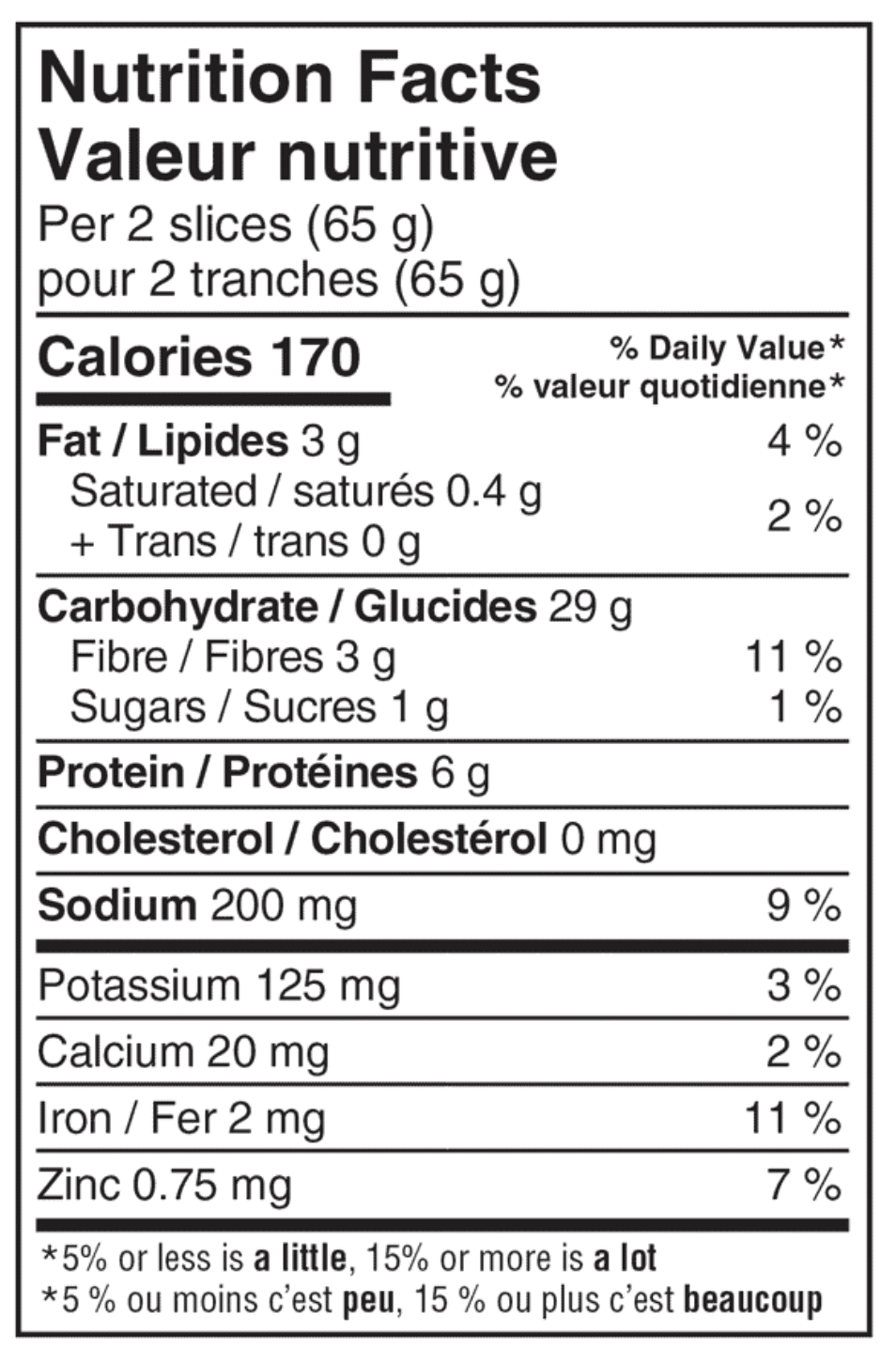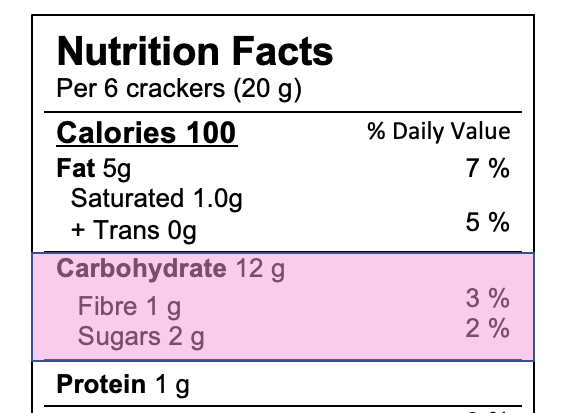The nutrition facts table is a helpful tool for understanding the nutrition content of food products. But for many Canadians, the added information can make selecting products overwhelming. We’re breaking down how to read nutrition labels in Canada to help you make informed choices at the grocery store.
What nutrients are listed on a nutrition facts table?
In Canada, the nutrition facts table must contain a minimum of 12 core nutrients: calories, fat, saturated fat, trans fat, carbohydrates, fibre, sugars, protein, cholesterol, sodium, potassium, calcium, and iron. Some food products may contain additional nutrient information, such as unsaturated fats, or additional micronutrients, but this is a choice of the food company and not required by law.
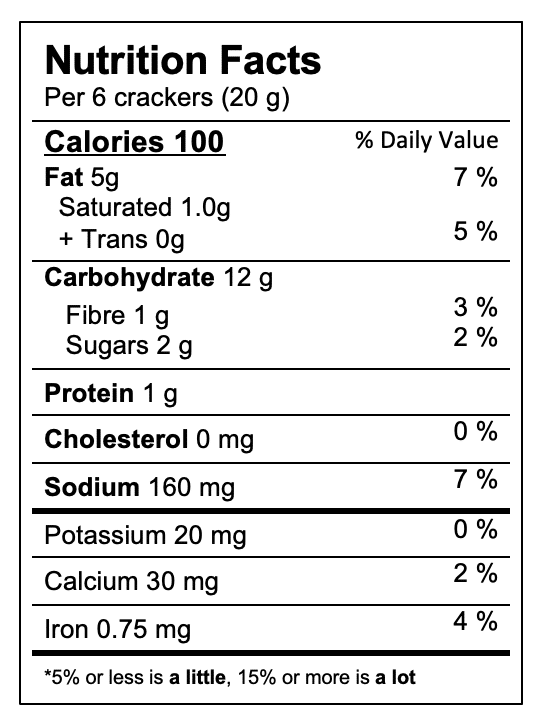
What is different about the new nutrition facts table in Canada?
As of 2021, an updated nutrition facts table has been in effect in Canada. Here is a summary of the changes:
Serving size: the serving size on the nutrition facts table now stands out more and will be consistent between brands. Previously, there was little consistency in serving sizes in comparable products, for example, cereal, which made it very difficult to compare products.
Calories: the calorie content is now bolded to stand out more on the nutrition label.
Sugar: a percent daily value has been added for sugar, as this nutrient is now identified as being of public health concern.
Micronutrients: the amount of micronutrients present per serving must be listed. Previously, only a percent daily value was included on the label for micronutrients. The required micronutrients have also been updated to include a minimum of potassium, calcium, and iron. Previously, vitamin A, vitamin C, calcium, and iron were required,
Percent daily value: a description of how to use the percent daily value is now included in the footer of the nutrition facts table.
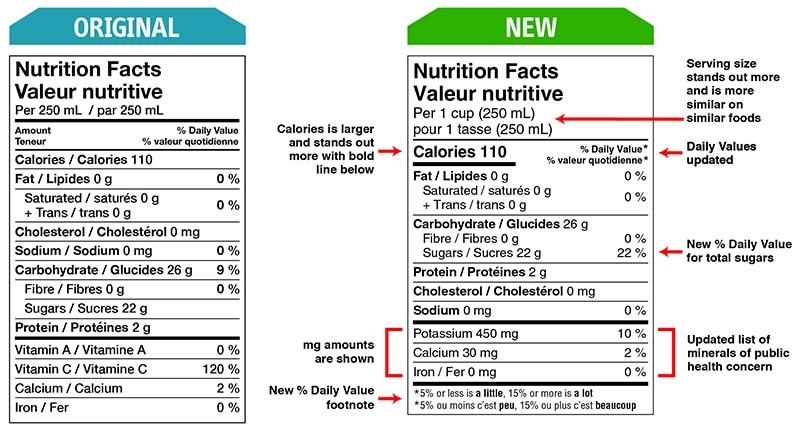
Health Canada recently released new front-of-package nutrition labeling regulations, requiring companies to include a symbol on food packaging indicating if it is high in sugar, salt, or saturated fat. Read everything you need to know about Health Canada Front of Package Labelling here.
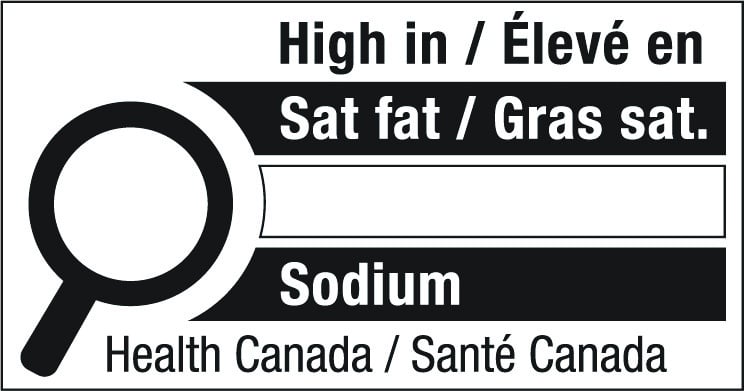
Are there any products without a nutrition facts table?
Any packaged product sold in grocery stores across Canada must contain a nutrition facts table with the above 12 core nutrients. The only foods that are not required to have a nutrition facts table are as follows:
- Fresh vegetables and fruit
- Raw meat and poultry (except when ground)
- Raw seafood
- One-bite confections that are individually sold
- Milk sold in refillable glass containers
- Individual servings of food meant to be eaten immediately
- Food prepared fresh in-store, such as bakery items or salads
- Alcoholic beverages
- Foods that contain very few nutrients, such as coffee, tea, vinegar, and spices
How to Read Nutrition Labels in Canada
Percent Daily Value on the Nutrition Facts Table
Before we get into the rest of the numbers, let’s review the percent daily value. The percent daily value (or % DV) is a tool on the nutrition facts table aimed to help simplify label reading for consumers. The percent daily value represents the percent of daily nutrient needs for the average Canadian consuming a 2000-calorie diet. For example, the label below contains 7% DV of fat, meaning that one serving of crackers provides 7% of your daily fat needs.
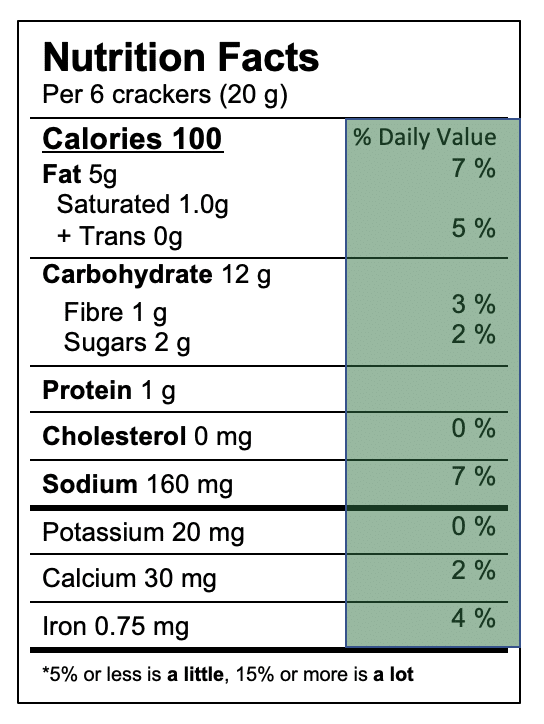
Percent daily value serves two purposes:
First, % DV helps consumers assess if a product contains a lot or a little of a nutrient. For example, you may look at the label above and see 160 mg sodium. This number is meaningless for most consumers who don’t know how much sodium they should consume in a day. However, most consumers understand percentages, which helps to put the amount into perspective. In the example above, the product provides 7% of your daily sodium needs. As a reference point, anything <5% is a little of a nutrient, and anything >15% is a lot of a nutrient.
Therefore, if you’re looking to get a high amount of a nutrient in a product, such as iron, you’ll want to select something with >15% DV of iron. The opposite will be true for nutrients you want less of, such as sodium.
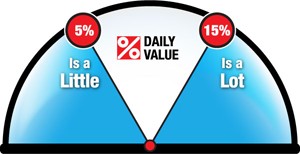
Second, the percent daily value serves as a comparison tool. The % DV helps customers easily compare two products based on the amount (percent of daily needs) of a nutrient that is present in the product. For example, a consumer looking at the sodium content in two different products – 400mg vs. 700mg – may not know if 300mg of sodium is a significant difference. However, comparing the % DV for sodium – 17% DV vs. 30% DV can provide more meaningful insight.
What are the percent daily values in Canada based on?
In Canada, the %DV is based on the following values. These values are meant to meet the needs of most Canadians, and may not be accurate for all Canadians. For this reason, the % DV isn’t meant to be used to add up your intake of core nutrients for the day as it may not reflect the needs of each individual person.
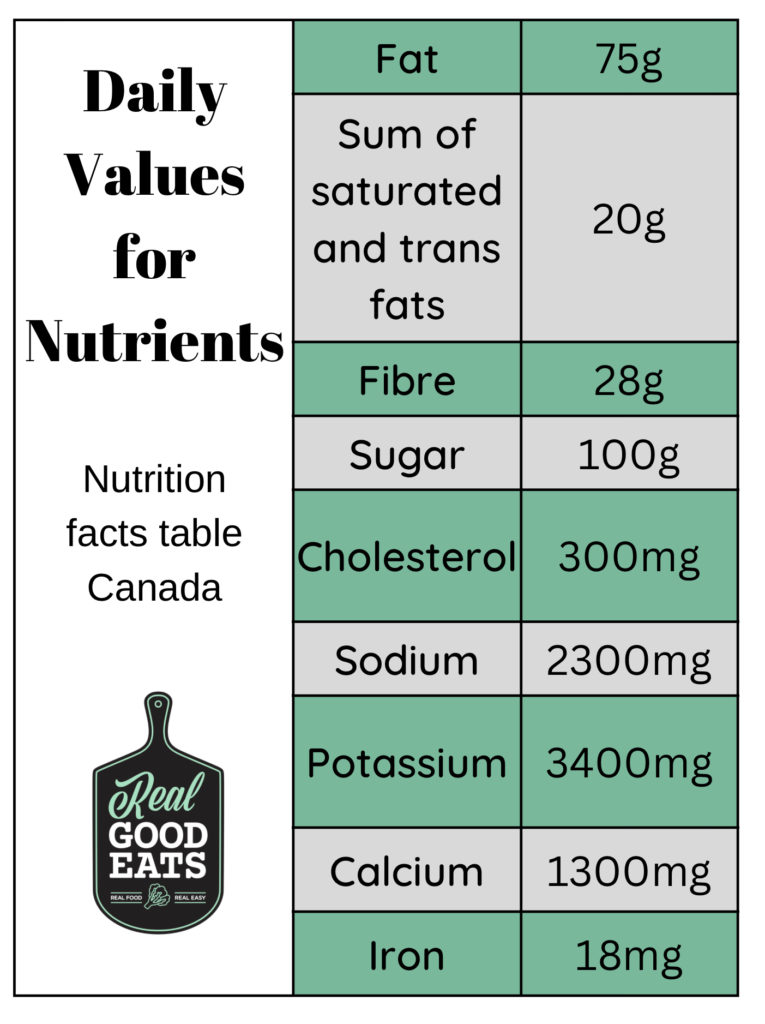
How to read nutrition labels in Canada (9 steps)
-
Consider the type of product you’re looking at
The first step to understanding nutrition labels, consider the food you’re looking at as a whole and not as a series of single nutrients. The values found on the nutrition facts table may be meaningful in different ways depending on the product in question, so considering the food as a whole can help put the numbers into context.
Also, it’s not necessary to assess every number on the nutrition facts table for each product. Considering the product as a whole can help narrow your focus and save time. For example, if you look at the Nutrition Facts table below without context, it’s difficult to assess the nutrition facts. But, once we know that we are looking at crackers, we can narrow our focus to look at some priority nutrients – carbohydrates (fibre) and sodium, in this case.
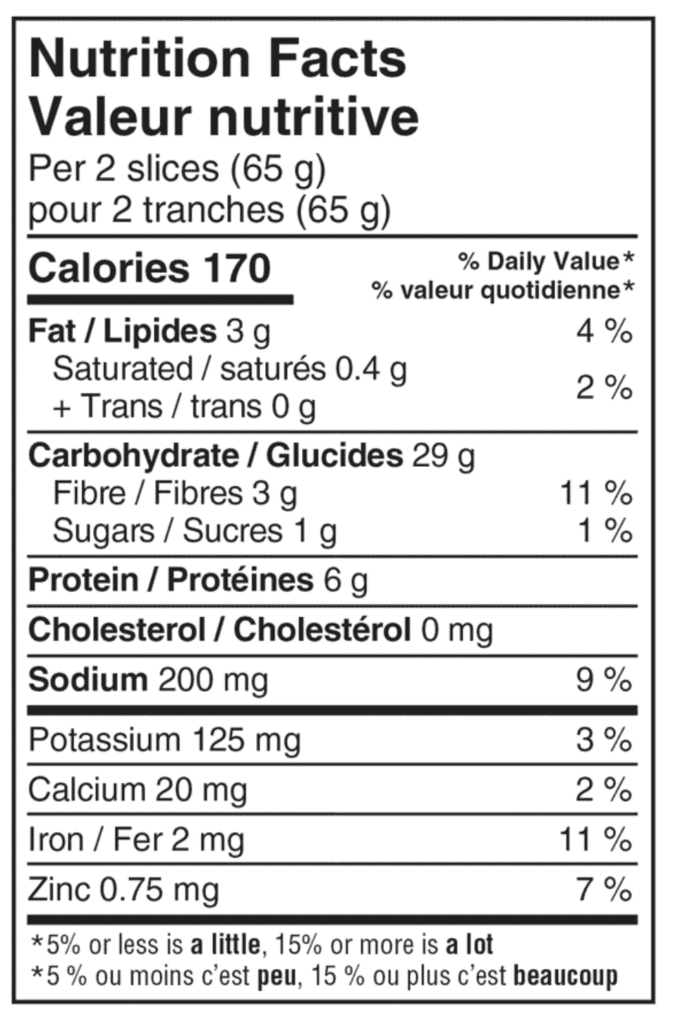
-
Serving Size
Next, you’ll want to look at the serving size. The serving size is listed using common measures you use at home (ex. tbsp, cup) followed by a metric unit (ml for liquids and g for solids). The metric unit represents the volume (fluid) or weight (solids) of the specified portion of food. For example, the serving size in the label below is 6 crackers and the weight of 6 crackers is 20g.
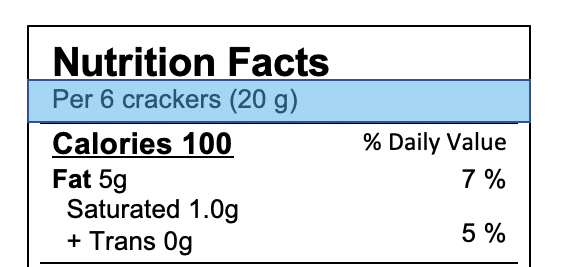
The serving size is important because the numbers below on the nutrition facts table reflect the nutrition in that portion of food. You’ll want to compare the serving size on the label to what you would actually consume in a sitting. If you’re eating more/less than the serving on the label, you’ll have to do some math to determine how much nutrition is in the serving you’re eating. For example, if a serving size of cereal is ½ cup but you consume 1 cup, you’ll need to multiply the nutrition facts by 2 to get the nutrition information for your portion of cereal.
How to Read Nutrition Labels in Canada
-
Calories
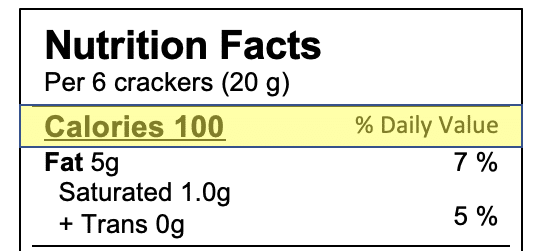
Calories is the first number on the nutrition facts table. The calories on a food label are bolded to help this number stand out to consumers. However, the calorie content of a food is the least helpful tool on a nutrition label. Here’s why: calories in a food product will come from one or a combination of the three macronutrients – fat, carbohydrates, and protein. Our body needs and utilizes these three nutrients for different reasons.
By looking at calories alone and not considering which macronutrients the calories are coming from, we’re only seeing a snapshot of the product and not the nutrient content the product is providing. For example, a product with 300 calories coming from sugar will be processed much differently by our body than 300 calories from a combination of fats, carbohydrates, and protein. For this reason, we suggest skipping past this part altogether and focusing on the macronutrient content to assess your product.
-
Fat
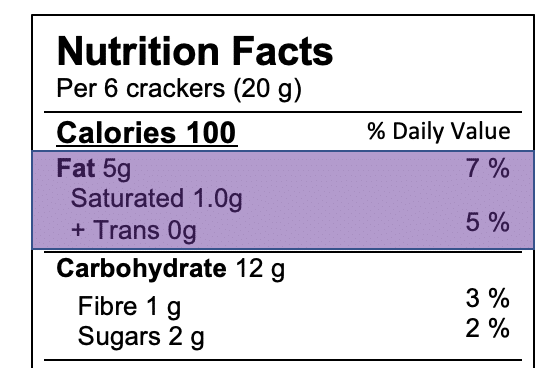
The first macronutrient listed on the nutrition facts table is fat. Fat is listed first in bold text. This represents the amount of total fat per serving in the product. Saturated and trans fat are listed next below total fat. These numbers are included in the total fat value above. For example, this product has 5g of total fat per serving. Of that 5g, 1g is saturated fat and 0g is trans fat. The remaining 4g of fat comes from unsaturated fat, which is not required as part of the core nutrients on a food label.
The percent DV for fat is based on 75g for total fat and 20g for a combination of saturated and trans fat.
-
Carbohydrates
The second macronutrient listed is carbohydrates. First, total carbohydrates per serving are listed in bold text. Below total carbohydrates, two sub-types of carbohydrates are listed – fibre and sugar. For example, the product below has 12g of total carbohydrates per serving. Of that 12g of carbohydrate, 1g is fibre, and 2g is sugar. The remaining carbohydrate comes from starch, which is not required as part of the core nutrients on the food label.
There is no percent DV for total carbohydrates. The percent DV for fibre is based on 28g, which is lower than some health authorities recommend, and may not be suitable for everyone. The percent DV for sugar is based on 100g of sugar.
How to Read Nutrition Labels in Canada
-
Protein
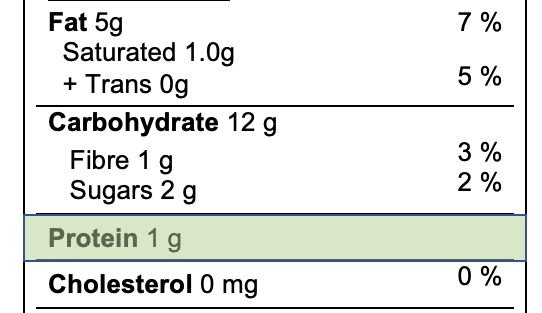
Protein is next on the food label and is listed as a single value in grams. Protein does not have a percent daily value. This is because most people get enough protein, so it’s not a nutrient of concern in Canada. Protein needs vary depending on a variety of factors. However, to help put this number into perspective, most adults would benefit from ~8-12g protein for a snack and 20-30g protein for a meal.
-
Cholesterol
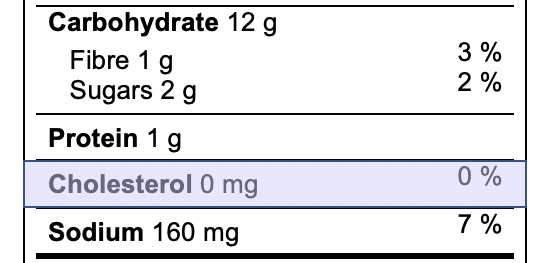
Cholesterol is listed next in mg per serving. The percent daily value for cholesterol is based on 300mg. Health Canada recommends consuming <300mg of cholesterol daily. For those with certain health conditions, a lower cholesterol intake may be recommended.
-
Sodium
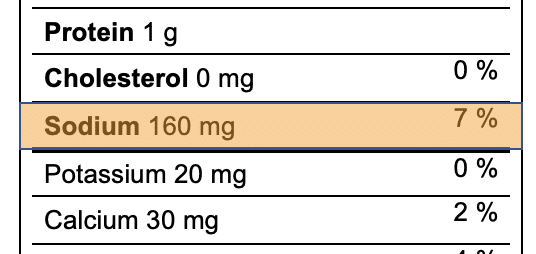
Sodium is next on the nutrition facts table and is listed in milligrams. The percent daily value for sodium is based on 2300mg. Health Canada recommends consuming less than 2300mg of sodium daily. Someone on a sodium-restricted diet may be required to consume less than this amount daily.
To put this into perspective, 1 tsp of table salt contains 2400mg of sodium.
How to Read Nutrition Labels in Canada
-
Micronutrients
There are three micronutrients required on the nutrition facts table in Canada. They are potassium, calcium, and iron. These are listed in both mg values and as a percent DV.
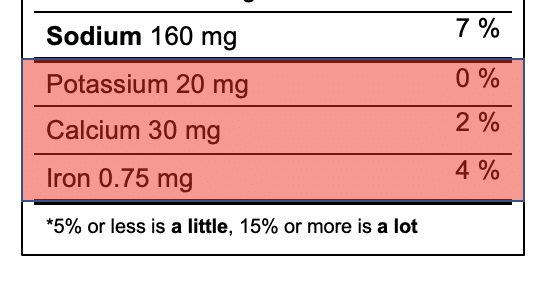
The percent daily value is based on an intake of 3400mg daily. The Adequate Intake of potassium for adults is 4700mg per day.
The percent daily value for calcium is based on an intake of 1300mg per day. The recommended daily allowance for calcium for adults ranges between 1000-1200mg, depending on age and sex.
The percent daily value for iron is based on 18mg per day. The recommended daily allowance for iron is 8mg for adult males and 18mg for adult females until 51 years of age (then the recommended intake reduces to 8 mg/d).
Still have questions about how to read nutrition labels in Canada? Leave your question in the comment section below!
Sources:
Health Canada Percent Daily Value (accessed April 2023).
Health Canada Dietary Reference Intakes (accessed April 2023).
Health Canada Changes to the Nutrition Facts Table (accessed April 2023).

